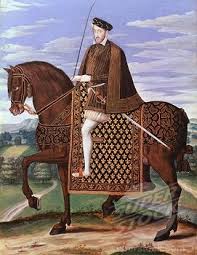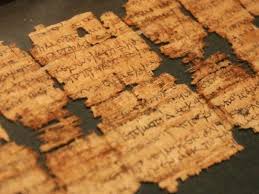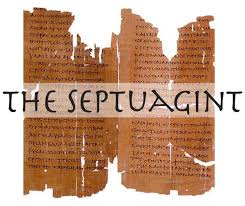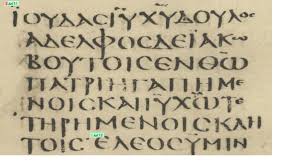
The Old Testament scriptures were written in ancient Hebrew, a language substantially different than the Hebrew of today. These writings were passed down from generation to generation for thousands of years on scrolls made of animal skin, usually sheep, but sometimes deer or cow.
Parchment or papyrus were difficult to come by as materials upon which to write, and thus in many ancient texts of both the Greek New Testament and Hebrew Old Testament there is the space-saving device ofscriptio continua, that is, continued writing in which there are not even spaces between words or sentences. Of course, we do not possess any of the original autographs of the biblical books, but it is safe to infer from the evidence of the most ancient extant manuscripts that the autographs likewise contained little if any punctuation. Even question marks were not used commonly in Greek manuscripts until the ninth century A.D.1 his work was not the best. Von Soden complained,
his work was not the best. Von Soden complained, but also the precise letter-text of the biblical books in Judaism, as well as their vocalization and accentuation for both public reading and private study. The MT is also widely used as the basis for translations of the Old Testament in Protestant Bibles, and in recent decades also for Catholic Bibles.
but also the precise letter-text of the biblical books in Judaism, as well as their vocalization and accentuation for both public reading and private study. The MT is also widely used as the basis for translations of the Old Testament in Protestant Bibles, and in recent decades also for Catholic Bibles. Latin and derives from a tradition that seventy-two Jewish scholars (seventy being the nearest round number) translated the Pentateuch (orTorah) from Hebrew into Greek for one of the Ptolemaic kings, Ptolemy II Philadelphus, 285-246 BC.[2]
Latin and derives from a tradition that seventy-two Jewish scholars (seventy being the nearest round number) translated the Pentateuch (orTorah) from Hebrew into Greek for one of the Ptolemaic kings, Ptolemy II Philadelphus, 285-246 BC.[2]
Parchment or papyrus were difficult to come by as materials upon which to write, and thus in many ancient texts of both the Greek New Testament and Hebrew Old Testament there is the space-saving device ofscriptio continua, that is, continued writing in which there are not even spaces between words or sentences. Of course, we do not possess any of the original autographs of the biblical books, but it is safe to infer from the evidence of the most ancient extant manuscripts that the autographs likewise contained little if any punctuation. Even question marks were not used commonly in Greek manuscripts until the ninth century A.D.1
 his work was not the best. Von Soden complained,
his work was not the best. Von Soden complained, but also the precise letter-text of the biblical books in Judaism, as well as their vocalization and accentuation for both public reading and private study. The MT is also widely used as the basis for translations of the Old Testament in Protestant Bibles, and in recent decades also for Catholic Bibles.
but also the precise letter-text of the biblical books in Judaism, as well as their vocalization and accentuation for both public reading and private study. The MT is also widely used as the basis for translations of the Old Testament in Protestant Bibles, and in recent decades also for Catholic Bibles. Latin and derives from a tradition that seventy-two Jewish scholars (seventy being the nearest round number) translated the Pentateuch (orTorah) from Hebrew into Greek for one of the Ptolemaic kings, Ptolemy II Philadelphus, 285-246 BC.[2]
Latin and derives from a tradition that seventy-two Jewish scholars (seventy being the nearest round number) translated the Pentateuch (orTorah) from Hebrew into Greek for one of the Ptolemaic kings, Ptolemy II Philadelphus, 285-246 BC.[2]
When the entire Pentateuch is present on a scroll, it is called a “Torah”. An entire Torah Scroll, if completely unraveled, is over 150 feet long! As most sheep are only about two to three feet long, it took an entire flock of sheep to make just one Torah scroll. The Jewish scribes who painstakingly produced each scroll were perfectionists. If they made even the slightest mistake in copying, such as allowing two letters of a word to touch, they destroyed that entire panel (the last three or four columns of text), and the panel before it, because it had touched the panel with a mistake!
The present chapter divisions in our Bibles were invented in 1205 by Stephen Langton, a professor in Paris (he later became Archbishop of Canterbury), who put these into a Vulgate edition of the Bible. These chapter divisions were first used by the Jews in 1330 for the Hebrew Old Testament in a manuscript and for a printed edition in 1516. This system of chapter divisions likewise came into the Greek manuscripts of the New Testament in the 1400s.
It was Robert Stephanus, a Parisian book printer, whose versification of the Bible has prevailed to the present. He took over the verse divisions already indicated in the Hebrew Bible by the soph pasuq and assigned numbers to them within the chapter divisions already assigned by Stephan Langton. While riding on horseback from Paris to Lyons he affixed his own verse divisions to the New Testament and numbered them within Langton’s chapter divisions. Consequently the quality of
The verse divisions of Stephanus which he, according to an incidental remark by his son, made during a trip from Paris to Lyons, frequently do not do service to the sense of the text. There is no consistent method at work in this system. The verses sometimes coincide with a single sentence, and sometimes they include several sentences; sometimes a single sentence is divided into two verses, with the result that the reader is led to consider the second verse while forgetting the point of view of the first verse. Especially objectionable is the way in which words introducing a direct quotation sometimes belong to the preceding verse and sometimes to the verse in which the quotation is found.3
But through Stephanus the versification of the Old Testament found its way into the Hebrew Bible printed first in 1571. Then Theodor Beza’s use of Stephanus’ verse and chapter divisions in his edition of the textus receptus of the New Testament (1565) assured them the permanence that they enjoy in our Bibles today.4
By approximately 500 BC, the 39 Books that make up the Old Testament were completed, and continued to be preserved in Hebrew on scrolls. As we approach the last few centuries before Christ, the Jewish historical books known as the “Apocrypha” were completed, yet they were recorded in Greek rather than Hebrew. By the end of the First Century AD, the New Testament had been completed. It was preserved in Greek on Papyrus, a thin paper-like material made from crushed and flattened stalks of a reed-like plant. The word “Bible” comes from the same Greek root word as “papyrus”. The papyrus sheets were bound, or tied together in a configuration much more similar to modern books than to an elongated scroll.
By 500 AD the Bible had been translated into over 500 languages. Just one century later, by 600 AD, it has been restricted to only one language: the Latin Vulgate! The only organized and recognized church at that time in history was the Catholic Church of Rome, and they refused to allow the scripture to be available in any language other than Latin. Those in possession of non-Latin scriptures would be executed! This was because only the priests were educated to understand Latin, and this gave the church ultimate power… a power to rule without question… a power to deceive… a power to extort money from the masses. Nobody could question their “Biblical” teachings, because few people other than priests could read Latin. The church capitalized on this forced-ignorance through the 1,000 year period from 400 AD to 1,400 AD knows as the “Dark and Middle Ages”.
Pope Leo the Tenth established a practice called the “selling of indulgences” as a way to extort money from the people. He offered forgiveness of sins for a fairly small amount of money. For a little bit more money, you would be allowed to indulge in a continuous lifestyle of sin, such as keeping a mistress. Also, through the invention of “Purgatory”, you could purchase the salvation of your loved-one’s souls. The church taught the ignorant masses, “As soon as the coin in the coffer rings, the troubled soul from Purgatory springs!” Pope Leo the Tenth showed his true feelings when he said, “The fable of Christ has been quite profitable to us!”
Ancient Versions
The Masoretic Text (MT) is the Hebrew text of the Jewish Bible (Tanakh). It defines not just the books of the Jewish canon,
The MT was primarily copied, edited and distributed by a group of Jews known as the Masoretes between the seventh and tenth centuries CE. Though the consonants differ little from the text generally accepted in the early second century, it has numerous differences of both little and great significance when compared to (extant 4th century) versions of the Septuagint, originally a Greek translation (around 300 BCE) of the Hebrew Scriptures in popular use in Palestine during the common era and often quoted in the second part of the Christian Bible (known as the New Testament).
The Septuagint (IPA: [‘sɛptuədʒɪnt]), or simply “LXX”, is the name commonly given in the West to the Koine Greek version of the Old Testament, translated in stages between the 3rd to 1st century BC in Alexandria.[1]
It is the oldest of several ancient translations of the Hebrew Bible into Greek. The word “septuaginta” means “seventy” in
The Vulgate (Vg) is an early 5th century version of the Bible in Latin which is largely the result of the labors ofJerome, who was commissioned by Pope Damasus I in 382 to make a revision of the old Latin translations. The Vulgate was a substantial improvement over these earlier translations. Its Old Testament is the first Latin version translated directly from the Hebrew Tanakh rather than from the Greek Septuagint. It became the definitive and officially promulgated Latin version of the Bible of the Roman Catholic Church and ultimately took the name versio vulgata, which means simply “the published translation”. There are 76 books in the Clementine edition of the Vulgate Bible: 46 in the Old Testament, 27 in the New Testament, and 3 in the Apocrypha.
Timeline of Bible Translation History
1,400 BC: The first written Word of God: The Ten Commandments delivered to Moses.
500 BC: Completion of All Original Hebrew Manuscripts which make up The 39 Books of the Old Testament.
200 BC: Completion of the Septuagint Greek Manuscripts which contain The 39 Old Testament Books AND 14 Apocrypha Books.
1st Century AD: Completion of All Original Greek Manuscripts which make up The 27 Books of the New Testament.
315 AD: Athenasius, the Bishop of Alexandria, identifies the 27 books of the New Testament which are today recognized as the canon of scripture.
382 AD: Jerome’s Latin Vulgate Manuscripts Produced which contain All 80 Books (39 Old Test. + 14 Apocrypha + 27 New Test).
500 AD: Scriptures have been Translated into Over 500 Languages.
600 AD: LATIN was the Only Language Allowed for Scripture.
995 AD: Anglo-Saxon (Early Roots of English Language) Translations of The New Testament Produced.
1384 AD: Wycliffe is the First Person to Produce a (Hand-Written) manuscript Copy of the Complete Bible; All 80 Books.
1455 AD: Gutenberg Invents the Printing Press; Books May Now be mass-Produced Instead of Individually Hand-Written. The First Book Ever Printed is Gutenberg’s Bible in Latin.
1516 AD: Erasmus Produces a Greek/Latin Parallel New Testament.
1522 AD: Martin Luther’s German New Testament.
1526 AD: William Tyndale’s New Testament; The First New Testament printed in the English Language.
1535 AD: Myles Coverdale’s Bible; The First Complete Bible printed in the English Language (80 Books: O.T. & N.T. & Apocrypha).
1537 AD: Tyndale-Matthews Bible; The Second Complete Bible printed in English. Done by John “Thomas Matthew” Rogers (80 Books).
1539 AD: The “Great Bible” Printed; The First English Language Bible Authorized for Public Use (80 Books).
1560 AD: The Geneva Bible Printed; The First English Language Bible to add Numbered Verses to Each Chapter (80 Books).
1568 AD: The Bishops Bible Printed; The Bible of which the King James was a Revision (80 Books).
1609 AD: The Douay Old Testament is added to the Rheims New Testament (of 1582) Making the First Complete English Catholic Bible; Translated from the Latin Vulgate (80 Books).
1611 AD: The King James Bible Printed; Originally with All 80 Books. The Apocrypha was Officially Removed in 1885 Leaving Only 66 Books.
1782 AD: Robert Aitken’s Bible; The First English Language Bible (KJV) Printed in America.
1791 AD: Isaac Collins and Isaiah Thomas Respectively Produce the First Family Bible and First Illustrated Bible Printed in America. Both were King James Versions, with All 80 Books.
1808 AD: Jane Aitken’s Bible (Daughter of Robert Aitken); The First Bible to be Printed by a Woman.
1833 AD: Noah Webster’s Bible; After Producing his Famous Dictionary, Webster Printed his Own Revision of the King James Bible.
1841 AD: English Hexapla New Testament; an Early Textual Comparison showing the Greek and 6 Famous English Translations in Parallel Columns.
1846 AD: The Illuminated Bible; The Most Lavishly Illustrated Bible printed in America. A King James Version, with All 80 Books.
1885 AD: The “English Revised Version” Bible; The First Major English Revision of the KJV.
1901 AD: The “American Standard Version”; The First Major American Revision of the KJV.
1971 AD: The “New American Standard Bible” (NASB) is Published as a “Modern and Accurate Word for Word English Translation” of the Bible.
1973 AD: The “New International Version” (NIV) is Published as a “Modern and Accurate Phrase for Phrase English Translation” of the Bible.
1982 AD: The “New King James Version” (NKJV) is Published as a “Modern English Version Maintaining the Original Style of the King James.”
2002 AD: The English Standard Version (ESV) is Published as a translation to bridge the gap between the accuracy of the NASB and the readability of the NIV.
The above post may contain copyrighted material the use of which has not always been specifically authorized by the copyright owner. It is being made available in an effort to advance the understanding of environmental, political, human rights, economic, democracy, scientific, social justice, for the purpose of historical debate, and to advance the understanding of Christian conservative issues. It is believed that this constitutes a ”fair use” of any such copyrighted material as provided for in section 107 of the Copyright Law. In accordance with the title 17 U.S. C. section 107, the material in this post is shown without profit to those who have expressed an interest in receiving the included information for research and educational purposes.


No comments:
Post a Comment
Please feel free to make civil comment. Divergent views encouraged,